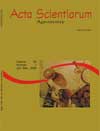<em>In vitro</em> propagation of Brazilian orchids using traditional culture media and commercial fertilizers formulations
Abstract
Some species of Brazilian orchids are practically extinct in their natural habitats. Large scale propagation of in vitro native orchids is a way of preserving them. Specific culture media for some species have already been described, but there are no studies on Catasetum fimbriatum and Cyrtopodium paranaensis. The aim of the present study was to establish in vitro propagation protocol of C. fimbriatum and C. paranaensis to reintroduce these species in natural habitat. The traditional culture media were: MS; MS modified with ½ macronutrients; MS modified with ¼ macronutrients, Vacin & Went and Knudson C. The commercial fertilizers formulations were: N.P.K (10-5-5) 2 mL L-1 and formulation N.P.K (10-30-20) 3 g L-1. The data, assessed six months after the beginning of the experiment, consisted of: number of roots, main root length, pseudobulb diameter, plant dry weight, root dry weight and plant height. The best results of C. fimbriatum plant development were obtained using MS medium complete and MS medium modified with half of macronutrients for canopy length. For the number of roots, the best results were obtained using MS modified with half of macronutrients. The best results for C. paranaensis plant development were obtained using MS modified with half of the macronutrients for canopy length and MS modified with ¼ of macronutrients for number of roots.Downloads
Download data is not yet available.
Published
2008-04-11
How to Cite
Rego-Oliveira, L. do V., & Faria, R. T. de. (2008). <em>In vitro</em> propagation of Brazilian orchids using traditional culture media and commercial fertilizers formulations. Acta Scientiarum. Agronomy, 27(1), 1-5. https://doi.org/10.4025/actasciagron.v27i1.1901
Issue
Section
Soils
DECLARATION OF ORIGINALITY AND COPYRIGHTS
I Declare that current article is original and has not been submitted for publication, in part or in whole, to any other national or international journal.
The copyrights belong exclusively to the authors. Published content is licensed under Creative Commons Attribution 4.0 (CC BY 4.0) guidelines, which allows sharing (copy and distribution of the material in any medium or format) and adaptation (remix, transform, and build upon the material) for any purpose, even commercially, under the terms of attribution.
2.0
2019CiteScore
60th percentile
Powered by 

2.0
2019CiteScore
60th percentile
Powered by 



















































